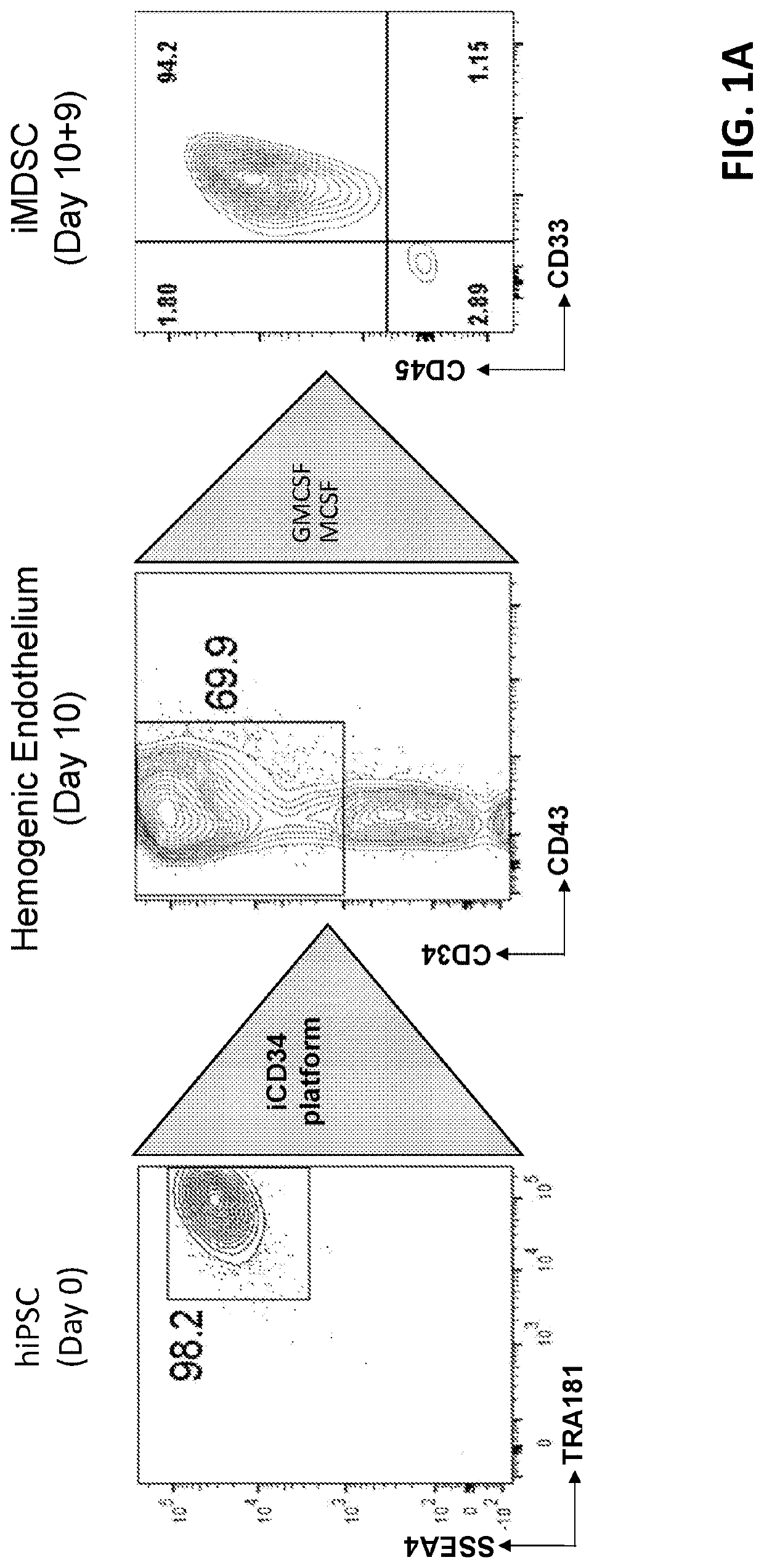Composition and methods for inducing myeloid suppressive cells and use thereof
a technology of suppressive cells and myeloid cells, which is applied in the field of adoptive immune cell therapy, can solve the problems of not producing sufficient mdscs for adoptive cell therapy, and achieve the effect of enhancing the therapeutic potential of cells
- Summary
- Abstract
- Description
- Claims
- Application Information
AI Technical Summary
Benefits of technology
Problems solved by technology
Method used
Image
Examples
example 1
ring Myeloid Derived Suppressor Cells from Induced Pluripotent Stem Cells
[0160]To initiate differentiation towards the hematopoietic lineage, hiPSCs were seeded as a monolayer on Day (D) 0 in the maintenance medium containing small molecules comprising ROCK inhibitor, MEK inhibitor and GSK3 inhibitor, and allowed to adhere and expand for about 24 hours. There was no formation of EB in this process. At D1, the maintenance medium was removed and replaced with base medium (for example, containing StemPro 34, glutamine, non-essential amino acids (NEAA), ascorbic acid, and monothioglycerol (MTG)) without the combination of small molecules. Hematopoietic differentiation was initiated at around D2 by switching the culture medium to iCD34-A (for example, comprising base medium, and BMP4). At D3, the culture medium was supplemented with the growth factor bFGF and switched to iCD34-B medium (for example, comprising base medium, BMP4, bFGF, and GSK3 inhibitor) subsequently for differentiation....
example 2
tently Suppressed T Cell Proliferation and Effector Function Independently of HLA Matching
[0169]To evaluate the functionality of iMDSCs, 5×104 previously frozen and banked ficoll-separated PBMCs from each of 5 independent donors were rested overnight, labeled with Cell Trace Violet (Invitrogen, Carlsbad, Calif.), and activated with anti-CD3 / 28 beads (ThermoFisher) at a ratio of 1:2. iMDSCs were co-cultured with activated PBMCs at a ratio of 1:1, 1:2, or 1:4 in complete RPMI medium in 96-well U bottom plates. Five days later co-cultures were harvested and T cell expansion was quantified via flow cytometry. PBMC / iMDSC co-cultures were washed, stained with Live / Dead Fixable Near-IR viability dye (eBioscience) to exclude dead cells, FC-blocked (BD Biosciences, San Diego, Calif.) for about 30 minutes on ice, and surface stained for about 30 minutes on ice with fluorescently conjugated antibodies (BD Biosciences and Biolegend, San Diego, Calif.) to CD3 (UCHT1), CD14 (M5E2), CD8α (RPA-T8),...
example 3
tenuates Graft versus Host Disease (GvHD)
[0173]To assess iMDSCs ability in attenuating GvHD, autoimmune diseases, or inflammatory indications in vivo, a xenogeneic acute GvHD mouse model was used. All animal experiments were approved and conducted in accordance with internal Institutional Animal Care and Use Committee. NSG mice (JAX #005557) were sub lethally irradiated with 2Gy, and one day later intravenously injected with 7.5×106 overnight rested PBMCs. Half of the mice also received 2.5×106 iMDSCs along with the injected PBMCs. Symptoms of clinical GvHD in the animals were scored up to 50 days, and the weight and survival of the animals were also monitored during the same period. On day 14 after treatment, peripheral blood was collected, red blood cell lysed, and stained with fluorescently conjugated antibodies (BD Biosciences and Biolegend) to mCD45 (30-F11), hCD45 (2D1), hCD3, hCD4, hCD25 (M-A251), and hCD127 (A019D5) to quantify levels of human chimerism (hCD45+mCD45−) and re...
PUM
| Property | Measurement | Unit |
|---|---|---|
| period of time | aaaaa | aaaaa |
| length of time | aaaaa | aaaaa |
| length of time | aaaaa | aaaaa |
Abstract
Description
Claims
Application Information
 Login to View More
Login to View More - R&D
- Intellectual Property
- Life Sciences
- Materials
- Tech Scout
- Unparalleled Data Quality
- Higher Quality Content
- 60% Fewer Hallucinations
Browse by: Latest US Patents, China's latest patents, Technical Efficacy Thesaurus, Application Domain, Technology Topic, Popular Technical Reports.
© 2025 PatSnap. All rights reserved.Legal|Privacy policy|Modern Slavery Act Transparency Statement|Sitemap|About US| Contact US: help@patsnap.com



